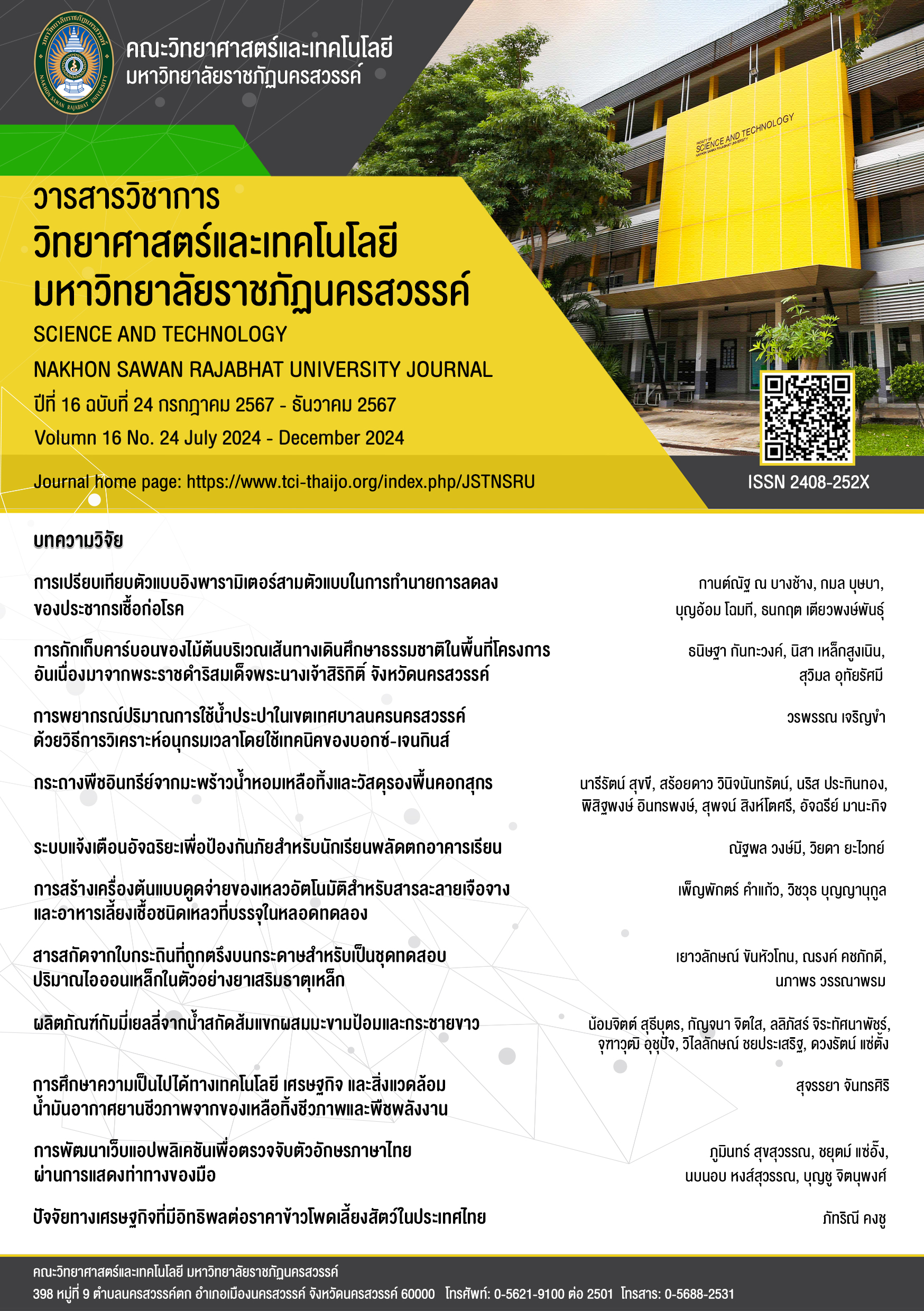สารสกัดจากใบกระถินที่ถูกตรึงบนกระดาษสำหรับเป็นชุดทดสอบปริมาณไอออนเหล็กในตัวอย่างยาเสริมธาตุเหล็ก
Main Article Content
Abstract
งานวิจัยนี้ได้ศึกษาหาปริมาณไอออนเหล็กในตัวอย่างยาเสริมธาตุเหล็กด้วยเทคนิคแลป-ออน-เปเปอร์ โดยใช้สารสกัดจากใบกระถินเป็นรีเอเจนต์ ร่วมกับการตรวจวัดค่าสี RGB ด้วยโทรศัพท์มือถือ การเกิดปฏิกิริยาระหว่างสารมิโมซีนในใบกระถินกับไอออนเหล็กจะได้สารประกอบเชิงซ้อนสีส้มอิฐ ให้สเปกตราการดูดกลืนแสงสูงสุดที่
460 nm โดยได้ศึกษาตัวแปรต่าง ๆ เพื่อให้ได้สภาวะที่เหมาะสมพบค่าที่เหมาะสม คือ ความเข้มข้นของสารสกัดใบกระถินที่ 2.5 %w/v เวลาในการสกัด 20 นาที pH ในการเกิดปฏิกิริยา 4.5 ปริมาตรสารละลายตัวอย่างที่หยดบนกระดาษเท่ากับ 15 ไมโครลิตร เวลาในการทำปฏิกิริยา 7.5 นาที และใช้แสงสีน้ำเงิน (B) ในการติดตามสัญญาณ ซึ่งภายใต้สภาวะการทดลองที่เหมาะสม พบช่วงการใช้งานที่เป็นเส้นตรงของสารละลายมาตรฐานเหล็กอยู่ในช่วง 1.00–10.00 ppm (y = 0.9626x – 2.1379, R2 = 0.9959) ค่า LOD และ LOQ เท่ากับ 0.09 และ 3.68 ppm ตามลำดับ และค่าความแม่นยำในการวิเคราะห์ของเทคนิคที่พัฒนาขึ้นที่ความเข้มข้นของสารละลายมาตรฐานเหล็ก 1.00, 5.00 และ 10.00 ppm (n = 8) พบว่า %RSD เท่ากับ 3.00 2.84 และ 2.38 ตามลำดับ ร้อยละการได้คืนกลับ 87–93% จากการวิเคราะห์ไอออนเหล็กในตัวอย่างยาพบว่า เมื่อเปรียบเทียบค่าการวิเคราะห์ทางสถิติแบบ t-Test ที่ระดับความเชื่อมั่น 95% ของวิธีที่พัฒนาขึ้นกับวิธีมาตรฐานของยาแต่ละชนิด พบว่าไม่มีความแตกต่างกันอย่างมีนัยสำคัญ งานวิจัยนี้ถือได้ว่าเป็นเครื่องมืออย่างง่าย มีความเป็นมิตรกับสิ่งแวดล้อมและราคาประหยัด
Article Details

This work is licensed under a Creative Commons Attribution-NonCommercial-NoDerivatives 4.0 International License.
References
เกศินี เสาวงจันทร์. (2562). การวิเคราะห์ปริมาณเหล็ก(III)ไอออนด้วยการเกิดสารเชิงซ้อนกับสารสกัดธรรมชาติโดยการใช้สมาร์ทโฟน [วิทยานิพนธ์ปริญญามหาบัณฑิต]. มหาวิทยาลัยบูรพา.
เกศินี เสาวงจันทร์ และ ศศิธร มั่นเจริญ. (2563). การพัฒนาเทคนิคการวิเคราะห์ปริมาณเหล็ก(III) โดยใช้สารสกัดแอนโทไซยานินจากธรรมชาติตรวจวัดด้วยสมาร์ทโฟน. วารสารวิทยาสศาสตร์และเทคโนโลยี, 28(8), 1372–1388. https://doi.org/10.14456/tstj.2020.110
คณาทิพย์ สิงห์หาย, อภิษฎา ศักดาวิโรจน์, กนกพิชญ์ เวชพาณิชย์กิจกุล, และ อสมาภรณ์ หมุนสมัย. (2563). การเปรียบเทียบสารประกอบฟีนอลิก สารฟลาโวนอยด์ และฤทธิ์การต้านอนุมูลอิสระในสารสกัดเอทานอลจากยอดอ่อน ใบ ผล เมล็ดของกระถินไทย. วารสารนเรศวรพะเยา, 13(3), 66–73. https://li01.tci-thaijo.org/index.php/journalup/article/view/246829
นภาพร วรรณาพรม และ เยาวลักษณ์ ขันหัวโทน. (2563). การพัฒนาอุปกรณ์อย่างง่ายที่อาศัยการแพร่ของแก๊สกับกระดาษที่ตรึงด้วยรีเอเจนต์ธรรมชาติและการวิเคราะห์ค่าสีจากภาพถ่ายดิจิทัลสำหรับวิเคราะห์แอมโมเนีย. วารสารวิจัยมหาวิทยาลัยเทคโนโลยีราชมงคลธัญบุรี, 19(1), 86–96. https://doi.org/10.14456/rj-rumtt.2020.8
ภูวดล เชื้อผู้ดี. (2563). การทดสอบเหล็กในน้ำโดยใช้เครื่อง Atomic Absroption Spectrometer ยี่ห้อ Analytik Jena รุ่น Zeenit 700 ด้วยเทคนิค Flame Atomization [รายงานการวิจัย]. มหาวิทยาลัยราชภัฏลำปาง.
Abdulkareem, E. A., Abdulsattar, J. O., & Abdulsattar, B. O. (2022). Iron (II) determination in lipstick samples using spectrophotometric and microfluidic paper-based analytical device (µPADs) platform via complexation reaction with iron chelator 1, 10-phenan-throline: A comparative study. Baghdad Science Journal. 19(2), 355–367. http://dx.doi.org/10.21123/bsj.2022.19.2.0355
Armenta, S., Esteve-Turrillas, F. A., & Herrero-Martínez, J. M. (2020). Development and evaluation of paper-based devices for iron(III) determination in an advanced undergraduate laboratory. Journal of Chemical Education, 97(10), 3852–3857. https://doi.org/10.1021/acs.jchemed.0c00369
Cai, L., Wu, Y., Xu, C., & Chen, Z. (2013). A Simple Paper-Based Microfluidic Device for the determination of the total amino acid content in a tea leaf extract. Journal of Chemical Education. 90(2), 232–234. https://doi.org/10.1021/ed300385j
Cappai, R., Fantasia, A., Melchior, A., Crisponi, G., & Nurchi, V. M. (2024). One-step determination of total iron using deferiprone or kojic acid as colorimetric reagents. Results in Chemistry, 7, 1–8. https://doi.org/10.1016/j.rechem.2024.101353.
Fakayode, S. O., King, A. G., Yakubu, M., Mohammud, A. K., & Pollar, D. A. (2022). Determination of Fe content of some food items by flame atomic absorption spectroscopy (FAAS): A guided-inquiry learning experience in instrumental analysis laboratory. Journal of Chemical Education, 89(1), 109–113. https://doi.org/10.1021/ed1011585
Grundl, T., & Delwiche, J. (1993). Kinetics of ferric oxyhydroxide precipitation. Journal of Contaminant Hydrology, 14(1), 71–87. https://doi.org/10.1016/0169-7722(93)90042-Q
Hussein Elgailani, I.E., & Alamary, H.S. (2017). Determination of iron content in iron deficiency drugs by UV-Visible spectrophotometer. Orbital: The Electronic Journal of Chemistry, 9(3), 151–156. http://dx.doi.org/10.17807/orbital.v9i3.953
Kehoe, E., & Penn, R. L. (2013). Introducing colorimetric analysis with camera phones and digital cameras: An activity for high school or general chemistry. Journal of Chemical Education, 90(9), 1191–1195. https://doi.org/10.1021/ed300567p
Koesdjojo, M. T., Pengpumkiat, S., Wu Y., Boonloed A., Huynh, D., Remcho, T. P. & Remcho, V.T. (2015). Cost effective paper-based colorimetric microfluidic devices and mobile phone camera readers for the classroom. Journal of Chemical Education, 92 (4), 737-741. https://doi.org/10.1021/ed500401d
Kotchabhakdi, N., Seanjum, C., Kiwfo, K., & Grudpan, K. (2021). A simple extract of Leucaena leucocephala (Lam) de Wit leaf containing mimosine as anatural color reagent for iron determination. Microchemical Journal, 162, 105860–105868. https://doi.org/10.1016/j.microc.2020.105860
Lai, H., Li, Z., Zhu, S., Cai, L., Xu, C., & Zhou, Q. (2020). Naked-eye detection of aluminum in gastric drugs on a paper-based analytical device. Journal of Chemical Education, 97(1), 295–299. https://doi.org/10.1021/acs.jchemed.9b00569
López-Marzoa, A. M., & Merkoçi, A. (2016). Paper-based sensors and assays: a success of the engineering design and the convergence of knowledge areas. Lab on chip, 16, 3150-3176. https://doi.org/10.1039/D3LC00978E
Ravgiala, R. R., Weisburd, S., Sleeper, R., Martinez, A., Rozkiewicz, D., Whitesides, G. M., & Hollar, K. A. (2014). Using paper-based diagnostics with high school students to model forensic investigation and colorimetric analysis. Journal of Chemical Education, 91(1), 107–111. https://doi.org/10.1021/ed300261a
Ruzmetov, U., Jumaeva, E., Orziqulov, B., & Smanova, Z. (2023). Determination of iron in water by flame atomic absorption spectrometry with sorption preconcentration. Industrial laboratory Diagnostics of materials, 89(12), 22–30. https://doi.org/10.26896/1028-6861-2023-89-12-22-30.
Singh, A. T., Lantigua, D., Meka, A., Taing, S., Pandher, M., & Camci-Unal, G. (2018). Paper-based sensors: Emerging themes and applications. Sensors, 18, 1–22. https://doi.org/10.3390/s18092838
Wang, B., Lin, Z., & Wang, M. (2015). Fabrication of a paper-based microfluidic device to readily determine nitrite ion concentration by simple colorimetric assay. Journal of Chemical Education, 92 (4), 733–736. https://doi.org/10.1021/ed500644m
Weinges, K., & Nader, F. W. (1982). Proanthocyanidins. In: Pericles Markakis, editor. Anthocyanins as food colors (1sted.). New york: Academic Press A subsidiary of Harcourt Brace Javanovich.
Whitesides, G. M., Martinez, A. W., Phillips, S. T., & Butte M. J. (2007). Patterned paper as platform for inexpensive, low volume, portable bioassays. Angewandte Chemie International Edition, 46(8), 1318–1320. https://doi.org/10.1002/anie.200603817
Xia, Y., Chen, H., & Li, W. (2022). Spectrophotometric determination of Fe(II) EDTA-NO, Fe(II)EDTA/Fe(III)EDTA in chemical absorption-biological reduction integrated NOx removal system. Polish Journal of Environmental Studies, 31(4), 3335–3342. https://doi.org/10.15244/pjoes/183430.
Xiu-li, H. E., Xue-li, L.I., Yuan-ping, L. V., & Qiang, H. E. (2015). Composition and color stability of anthocyanin-based extract from purple sweet potato. Food Science and Technology (Brazil), 35(3), 468–73. http://dx.doi.org/10.1590/1678-457X.6687


